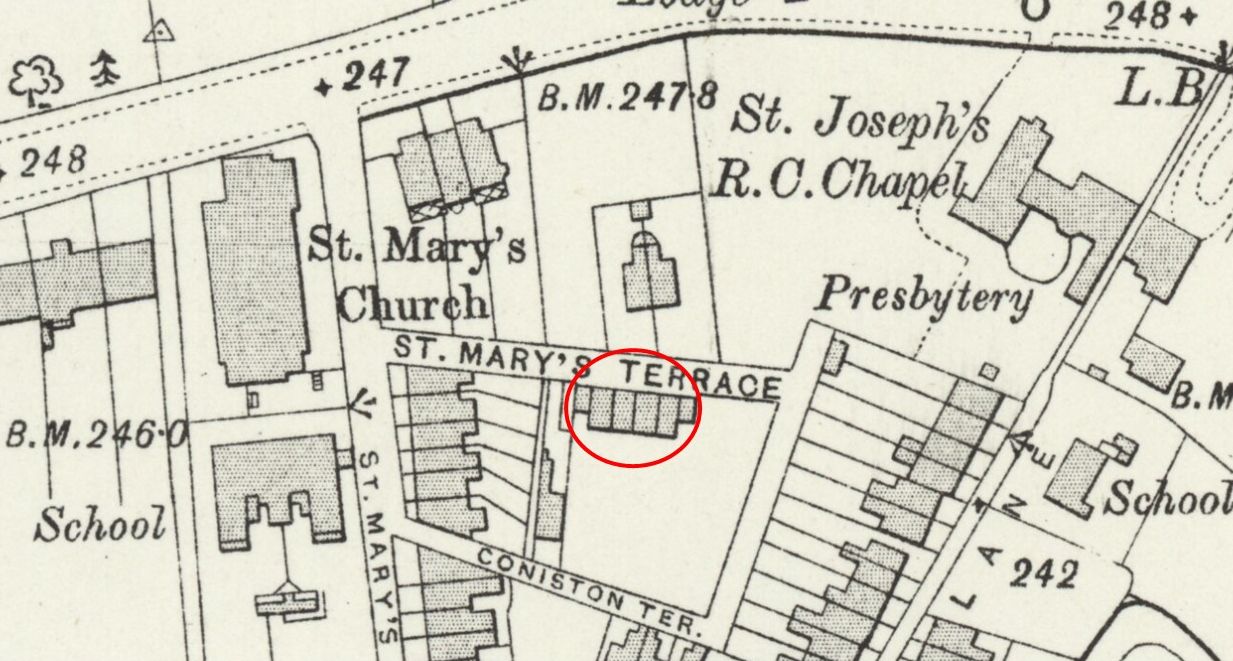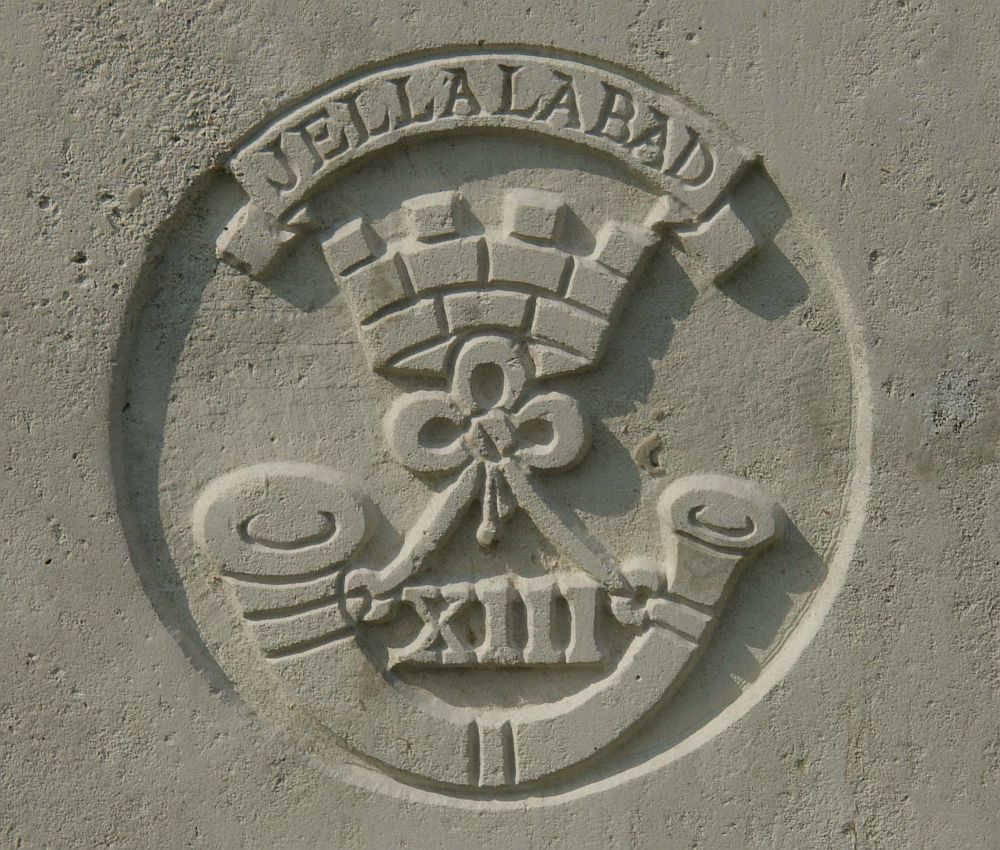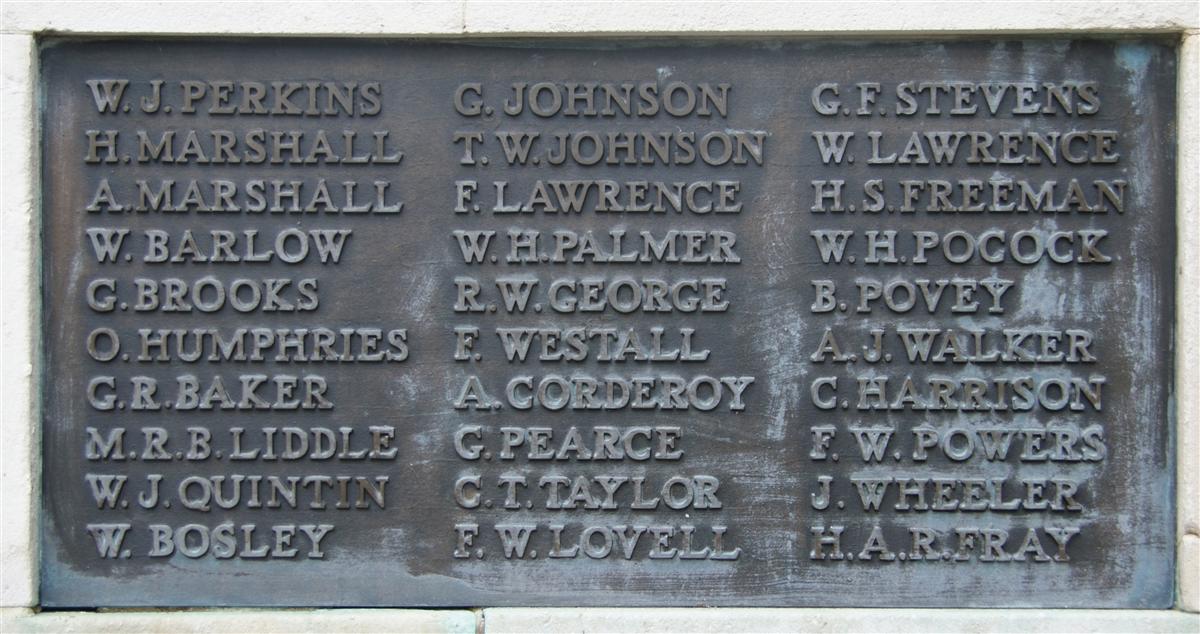William John Perkins
Private 20515 William John Perkins, 6th Battalion, Somerset Light Infantry.

St Mary's Cottages (circled) in Speenhamland. |
Given where they were living one might expect William to attend Speenhamland School, behind St Mary'schurch at the end of their short street, but he was not recorded on the school's war memorial. Nor is he remembered on any known nonconformist memorial (the school was very much Church of England). The family could also have been Roman Catholic in which case he would have attended the other school on the map above (behind St Joseph's RC Chapel). He was, however, remembered on the St Mary's parish memorial.
At the time of the 1911 census William was an unemployed fifteen-year-old; as no later record of his civilian life has been uncovered his later employment remains a mystery.

The regimental badge of the Somerset Light Infantry, as used on CWGC headstones. |
On 21 March 1918 he was serving with C Company of the 6th Battalion Somerset Light Infantry (43rd Brigade, 14th (Light)Division). The division was a part of the British Fifth Army under General Hubert Gough that had recently been tasked with the defence of a southward extension of the British line. This section had recently been held by the French and Gough was concerned at the state of the defences and by how thinly his men were spread - he had significantly fewer men per mile than in any other British sector. The British were also converting to a new form of defence in depth, which involved the construction of new strongpoints, trenches, barbed wire entanglements and a myriad of other issues. At the same time it was well known that an enemy offensive was imminent – US troops were beginning to trickle into France, soon the trickle would become a flood and the Germans would face insuperable odds, yet, in the spring of 1918 the enemy had numeric superiority as they had been reinforced by huge numbers of seasoned troops from the Eastern Front following the collapse of Russia.
On 21 March 1918 the attack came – and it came where the British were weakest. The Kaiserslaucht or German Spring Offensive hit the British Fourth and Fifth Armies at dawn – even the weather helped the German forces as they were hidden by a dense fog until they were upon the British defenders. The more strongly held Fourth Army sector bent but withstood the attack, the weakly held Fifth Army sector crumbled, soon Fourth Army was having to withdraw on its southern flank to stop German force getting around behind its line.
The 6th Battalion, Somerset Light Infantry was in the front line south of St Quentin – things did not go well:
War Diary, 6th Battalion Somerset Light Infantry – 21 March 1918
At 4.30am the enemy opened an intense bombardment with all calibre shells, using a new kind of gas shell, the smell of which was not unpleasant, but had the effect of sleeping gas. At 8.30am he finished gas shelling but continued with other shells. It was very foggy when sentries were posted at all points. All signal commn was cut by 4.40am. At 10.20 am news was recd by runner the enemy was in the front line, Support Coys, Bn HQ moved into strong points EGYPT where fighting immediately commenced. 2 pigeons were dispatched & papers etc burnt. The enemy at 10.30am were streaming down the St QUENTIN Road from both flanks & poured into LA FOZIE QUARRY. At 10.35am he was reported to be pushing towards BENAY and CERIZY. 1 officer, 6 runners & 3 signallers commenced to fight their way to Bde HQ with the news & to warn strong points. 1 officer reached Bde HQ 11.10am, 2 runners arriving 10 minutes after. 1 signaller also got over successfully. After which this party were attached to 9 Scottish Rifles in reserve trenches behind Bde HQ. Estimated Casualties 20 officers 540 other ranks actually in the front line at the time of the attack. The remnants of the Bn were under the orders of the 9th Scottish Rifles.
This is not a typical war diary entry – the reader familiar with such diaries will immediately notice that it is entirely about a very small portion of the battalion – the men at Battalion HQ. Normally one would read of the actions of the four companies, their dispositions, communications, etc, not about the small cadre of men at HQ. It appears to have been written by the one officer who escaped the maelstrom to Brigade HQ who continues to keep the diary for a few days more, despite the tiny remnant of the battalion being absorbed into another battalion.
The reality is that the entire battalion was overrun, outflanked and then surrounded in their defences – the loss of 20 officers and 540 men contrasting with the survival (for that day) of 1 officer and 3 men. Almost all of those lost would have been reported missing – because there were no witnesses to report the death of a comrade.
In the great battles of previous years the odds were that a man reported missing was, in fact, dead – during offense actions this was much more likely than a man being captured. However, this was not such an action and the Germans took huge numbers of prisoners as they advanced.
Naturally the parents of a man reported missing, as William was, were desperate to find out more about their son’s fate:
Newbury Weekly News, 6 June 1918 – Missing
Reported missing since March 21st, No. 20,515 Pte. W Perkins, C. Coy. Officers’ Mess. 6th Batt. Somerset L.I. Any information regarding the above named will be gratefully received by the parents, Mr and Mrs Perkins, 2, St Mary’s-cottages, London-road, Newbury.
Before long they would have heard via the Red Cross that William had been captured near Cerizy and was alive and as well as a PoW might be in a country suffering desperately from the privations brought on by war. He was in PoW camps at Stendhal, deep in Germany, and then at Metz in occupied France. PoWs were forced to work so the move to Metz may well mean that he was working on new German defences in the final days of the war.
At the end of the war he was soon repatriated, he landed at Dover on 3 December 1918. No doubt he got some leave, but he was soon back with the Army, probably awaiting demobilisation. Sadly, this was not to be – in February 1919 he was admitted to hospital with the flu, he died there on 28 February.
His body was returned to Newbury where it was laid to rest:
Newbury Weekly News, 13 March 1919 – Newbury
The funeral took place at the Municipal Cemetery, of Private William Perkins, who, after three years’ service in France, was reported missing in March 1918, and subsequently discovered to be a prisoner. Released at the Armistice, he came to England, and, after leave, returned to his depot, where he was attacked by influenza, and died of pneumonia. The body was brought to Newbury and carried to the grave by four Naval comrades: G Tompkins, S Willis, G Bowers, and W Spansick. The mourners were: father, mother, and sister, Mrs Moss (aunt), Mr and Mrs Newman (uncle and aunt), Mrs Mason and Miss Stroud (cousins). Wreaths were sent from father and mother and Aunt Rose, Sister Mabel, Uncle George and Aunt Mary, and Cousins, Maggie and Jessie (cousins), Mrs and Miss Finn, Miss Mabel and Alice Tidbury, George Tompkins, Sid Willis, George Bowers, Will Spanswick, Bert Morton, Harry Morton, Len Spansick, Boys Streek. The coffin was inscribed “William Perkins, 20515, Somerset Light Infantry, died February 28th, age 23,” Messrs Hart and Son were the undertakers.
 William's name on Newbury War Memorial. (upper left) |
Locally he is remembered on tablet 5 of the Newbury Town Memorial.
His name is also the Speenhamland Shrine , the parish memorial from St Mary’s, Speenhamland (demolished in the 1970s) now located in St Nicolas’ Church, Newbury. This church would have been very familiar to William because the family lived only a few yards from the church.

Find a memorial :
| Died this day: | |
| 15 January 1943 | |
| L C Lawrence | |
| Newbury |

Like this site? Show your appreciation through a donation to a great charity.